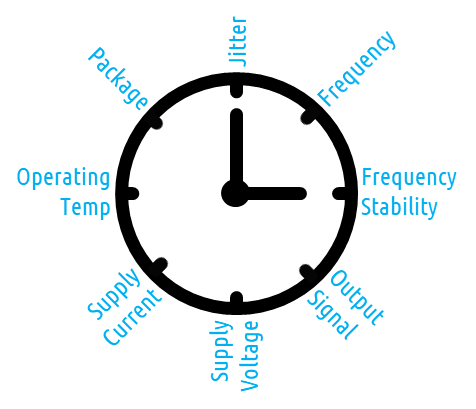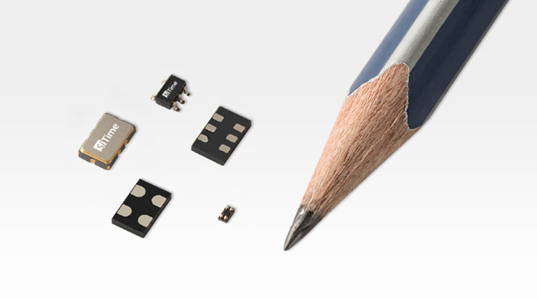What is the first thing you think of when selecting electronic components? Chances are it’s the processor or something else central to the system. The timing component may be the last thing on your mind, even though the clock provides the heartbeat on which all signals in the system are dependent.
8 Oscillator Settings to Consider
Selecting these essential timing components may appear to be a straightforward process, but there are a number of factors to consider that affect system performance. So what are the most important specifications and considerations? Here’s a short list of the top oscillator parameters and why they’re important. Of course there are more details to consider, so we’ve created an in-depth glossary that covers a broader range of oscillator characteristics.

Frequency
The most basic parameter for any oscillator is the frequency. It is the repetition rate (cycle) of the signal output from the oscillator and is measured in Hertz (Hz) per second. SiTime oscillators are available in frequencies as low as 1 Hz for low-power devices and as high as 725 MHz. The frequency of SiTime oscillators is programmable within this range to 6 decimals of accuracy. The use of custom frequencies can optimize system performance. Frequency can be factory programmed by SiTime, programmed by key distributors, or programmed for lower volumes in the customer’s lab using an oscillator programmer.
Frequency Stability
Frequency stability is a fundamental performance specification for oscillators. It is typically expressed in parts per million (ppm) or parts per billion (ppb) which is referenced to the nominal output frequency. It represents the deviation of output frequency due to external conditions; therefore, a smaller stability number means better performance. The definition of external conditions can differ for different oscillator categories, but it usually includes temperature variation and initial offset at 25°C. It may also include frequency aging over time, solder down frequency shift, and may include electrical conditions such as supply voltage variation and output load variation.
Output Signal Format
Chipset vendors may specify the required output signal mode for timing chips, or the system designer may have some leeway. Output types fall into two categories: single-ended or differential. Single-ended oscillators are lower cost and easier to implement, but they have limitations. They are somewhat sensitive to board noise and are therefore typically better suited for frequencies below 166 MHz. LVCMOS is the most common single-ended output type which swings rail-to-rail. SiTime also offers NanoDrive™ output, which is similar to LVCMOS, but has programmable output swing down to 200 mV to match the input requirements of the downstream chip, and to minimize power consumption.
Differential signaling is a more expensive option, but it enables better performance and is preferred for higher frequency applications. Since any noise common to both differential traces will be zeroed out, this mode is less sensitive to external noise and it generates lower levels of jitter and EMI. The most commonly used differential signal types are LVPECL, LVDS, and HCSL.
Supply Voltage
Supply voltage, specified in volts (V), is the input power required to operate the oscillator. Supply voltage powers the oscillator through the VDD pin and is sometimes referred to as VDD. Standard voltages for single-ended oscillators include 1.8, 2.5, and 3.3V. Voltages for modern differential oscillators typically range between 2.5 and 3.3V. SiTime offers oscillators that operate as low as 1.2V for regulated supply applications such as coin-cell or super-cap battery backup. The supply voltage of most SiTime oscillator families is programmable, which reduces the need for external components such as level translators or voltage regulators.
Supply Current
Supply current is the maximum operating current of an oscillator. It is measured in microamps (µA) or milliamps (mA) at the maximum and sometimes nominal supply voltage. Typical supply current is measured without load.
Operating Temperature
The operating temperature range is the temperature span in which all oscillator parameters are specified within in the datasheet. Common temperature ranges are listed below.
- Commercial, Automotive Grade 4: 0°C to 70°C
- Extended Commercial: -20°C to 70°C
- Industrial, Automotive Grade 3: -40°C to 85°C
- Extended Industrial, Automotive Grade 2: -40°C to 105°C
- Automotive Grade 1: -40°C to 125°C
- Military: -55°C to 125°C
- Automotive Grade 0: -40°C to 150°C
Packages
Oscillators are usually housed in metal, ceramic, or plastic packages. And they’re available in a variety of industry-standard package dimensions. The pad (pin) arrangements may vary among vendors, but the overall x-y dimensions are standardized. Here’s a list of common oscillator package sizes for single-ended oscillators, which usually have 4 pins. Differential oscillators, which have 6 pins, are typically available in the larger packages: 3225, 5032, and 7050.
- 2016: 2.0 x 1.6 mm
- 2520: 2.5 x 2.0 mm
- 3225: 3.2 x 2.5 mm
- 5032: 5.0 x 3.2 mm
- 7050: 7.0 x 5.0 mm
Some specialized oscillators, such as OCXOs are housed in significantly larger packages, often measuring 25.4 x 25.4 mm but can range from 9.7 x 7.5 mm to 135 x 72 mm.

In addition to these standard package sizes, SiTime offers a couple of unique packages to solve difficult design challenges. One is a tiny 1508 (1.5 mm x 0.8 mm) chip-scale package (CSP), which is the smallest oscillator package available. Another option is a leaded SOT23-5 package for applications that require higher board-level reliability and easier visual inspection during board assembly.
Jitter
Jitter is an important parameter, especially for digital communications applications. It is the short-term deviation from an ideal clock signal and is measured in picoseconds (ps) or nanoseconds (ns). Because jitter can be one of the main contributors to system timing errors, it’s critical to account for oscillator jitter when evaluating the total timing budget. This is not necessarily a simple matter. Oscillator manufacturers do not all specify jitter in the same way. Jitter requirements vary by application and there are various types of jitter and different integration ranges for integrated phase jitter which is measured in the frequency domain. To help sort this out, our glossary includes definitions for cycle to cycle (C2C) jitter, integrated phase jitter (IPJ), long-term jitter, period jitter, and phase noise. And our Clock Jitter Definitions and Measurement Methods app note provides even more information.
Other Parameters
The eight parameters listed above are the most common factors used when selecting an oscillator. But depending on the application, there can be many more characteristics and features that are important to consider. These include EMI reduction features, pull range options for fine-tuning frequency, start-up time, and quality/reliability (Q, DPPM, MTBF, FIT rate).
And for high-performance applications, there are a number of additional stability-related specifications to consider beyond basic frequency stability. These include aging, frequency vs temperature slope (ΔF/ΔT), thermal hysteresis, Allan deviation, Hadamard variance, holdover, and retrace.
To learn about these parameters and more, see our glossary – one of the most extensive oscillator definition guides available.
-----------------------------
Thanks to Jim Holbrook, Director of Customer Engineering SiTime, for his contributions to this article.